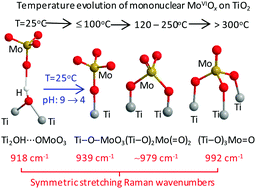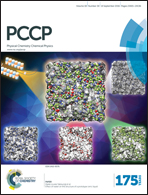Molybdena deposited on titania by equilibrium deposition filtration: structural evolution of oxo–molybdenum(vi) sites with temperature†
Abstract
The equilibrium deposition filtration (EDF) method, an advanced catalyst synthesis route that is based on a molecular level approach, can be used for tailoring the oxometallic phase deposited on a porous oxide support. Here, the EDF method is used for synthesizing (MoOx)n/TiO2 catalysts. In situ Raman spectroscopy in the temperature range of 25–450 °C, low temperature (77 K) EPR spectroscopy and DR-UV spectroscopy are used for studying the evolution of the structural configuration of oxo–MoVI species on TiO2 with increasing temperature as well as the influence of the supported (MoOx)n species on the photo-generation of electrons and holes of TiO2. This study concerns (MoOx)n/TiO2 samples in which the surface densities after calcination are 0.3, 2.6 and 3.9 Mo per nm2, thereby covering a very wide range of submonolayer coverage. The gradual heat treatment of the catalysts results in a transformation of the initially (prior to drying) deposited species and the pertinent species evolution at the nano-level is discussed by means of a number of mechanisms including anchoring, association, cleavage and surface diffusion.


 Please wait while we load your content...
Please wait while we load your content...